Civil Engineering Report: Mudgee Water System Design, Australia
VerifiedAdded on 2023/06/05
|21
|4217
|190
Report
AI Summary
This report details the design of a water supply system for Mudgee, New South Wales, Australia, focusing on addressing the challenges of water scarcity and increasing population. The study explores the use of groundwater and rainwater harvesting as primary water sources to meet the growing demands, particularly due to the development of a new university in the region. It covers various aspects of the water system, including the selection of pipe materials, pump design, storage tank sizing, and the analysis of water quality and population projections. The methodology includes the design of water distribution points, pump selection, and pipe design based on established engineering principles and standards. Findings and discussions encompass population estimation, water requirement calculations, groundwater supply analysis, and rainwater harvesting potential. The report concludes with recommendations for the implementation of the designed water supply system, emphasizing the importance of a sustainable and reliable water source for the residents of Mudgee.
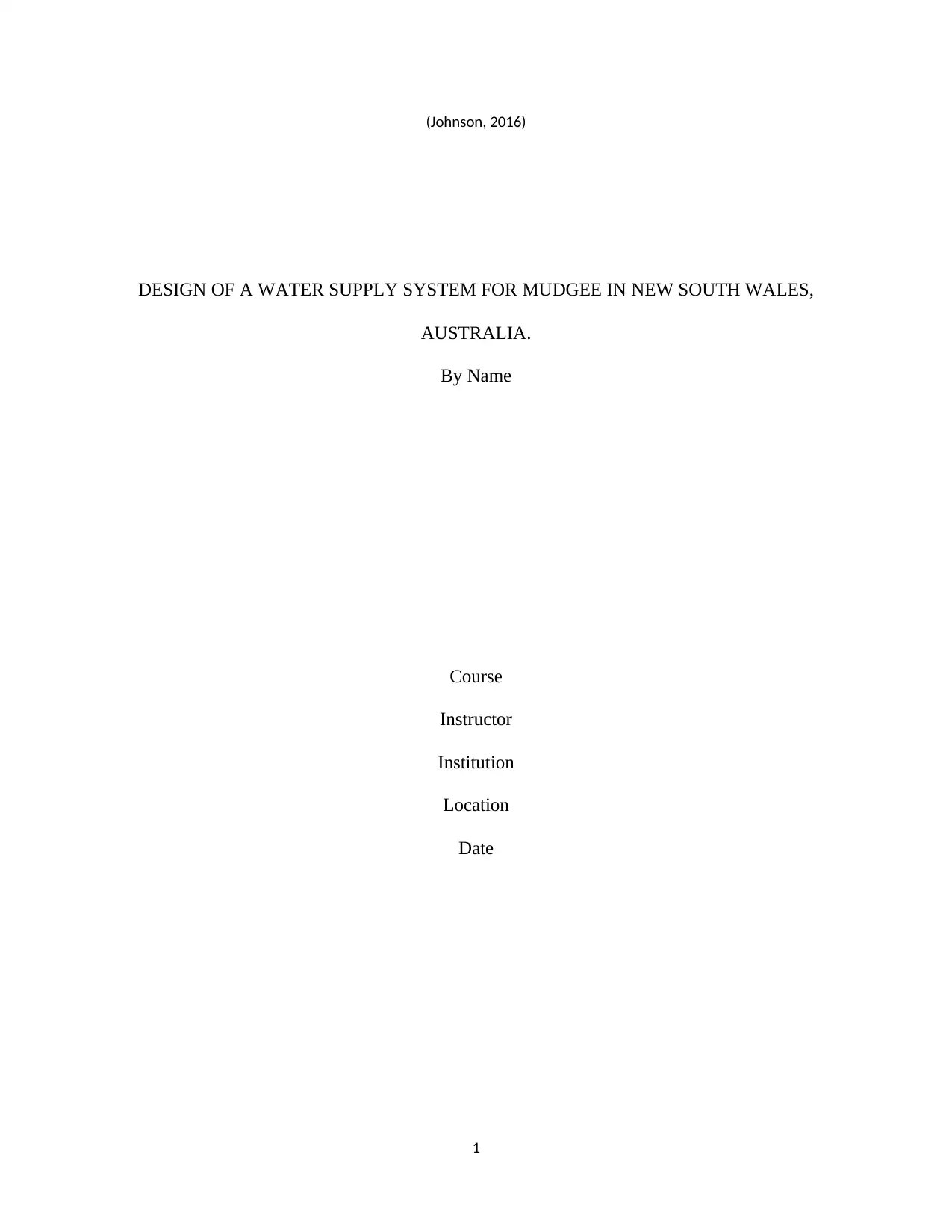
(Johnson, 2016)
DESIGN OF A WATER SUPPLY SYSTEM FOR MUDGEE IN NEW SOUTH WALES,
AUSTRALIA.
By Name
Course
Instructor
Institution
Location
Date
1
DESIGN OF A WATER SUPPLY SYSTEM FOR MUDGEE IN NEW SOUTH WALES,
AUSTRALIA.
By Name
Course
Instructor
Institution
Location
Date
1
Paraphrase This Document
Need a fresh take? Get an instant paraphrase of this document with our AI Paraphraser
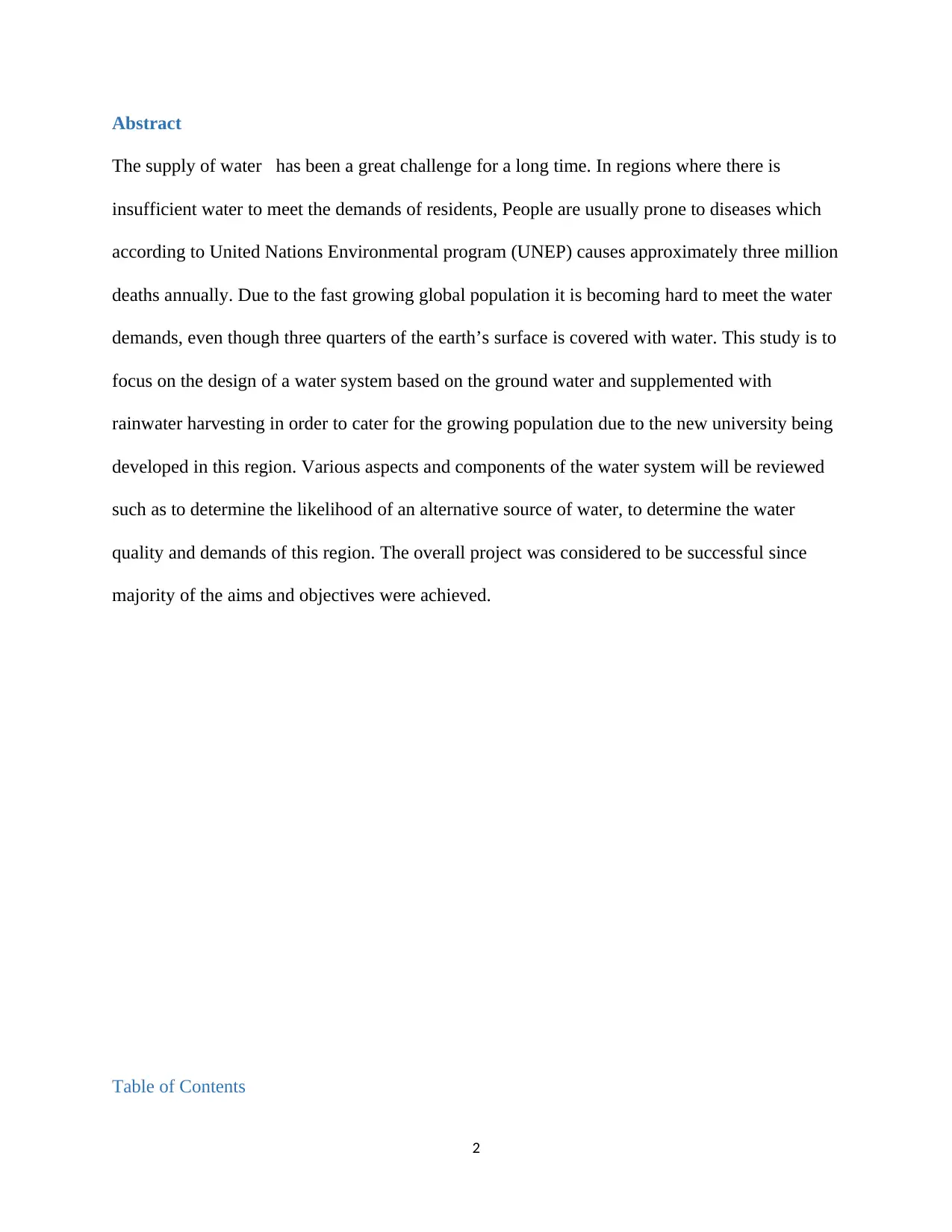
Abstract
The supply of water has been a great challenge for a long time. In regions where there is
insufficient water to meet the demands of residents, People are usually prone to diseases which
according to United Nations Environmental program (UNEP) causes approximately three million
deaths annually. Due to the fast growing global population it is becoming hard to meet the water
demands, even though three quarters of the earth’s surface is covered with water. This study is to
focus on the design of a water system based on the ground water and supplemented with
rainwater harvesting in order to cater for the growing population due to the new university being
developed in this region. Various aspects and components of the water system will be reviewed
such as to determine the likelihood of an alternative source of water, to determine the water
quality and demands of this region. The overall project was considered to be successful since
majority of the aims and objectives were achieved.
Table of Contents
2
The supply of water has been a great challenge for a long time. In regions where there is
insufficient water to meet the demands of residents, People are usually prone to diseases which
according to United Nations Environmental program (UNEP) causes approximately three million
deaths annually. Due to the fast growing global population it is becoming hard to meet the water
demands, even though three quarters of the earth’s surface is covered with water. This study is to
focus on the design of a water system based on the ground water and supplemented with
rainwater harvesting in order to cater for the growing population due to the new university being
developed in this region. Various aspects and components of the water system will be reviewed
such as to determine the likelihood of an alternative source of water, to determine the water
quality and demands of this region. The overall project was considered to be successful since
majority of the aims and objectives were achieved.
Table of Contents
2
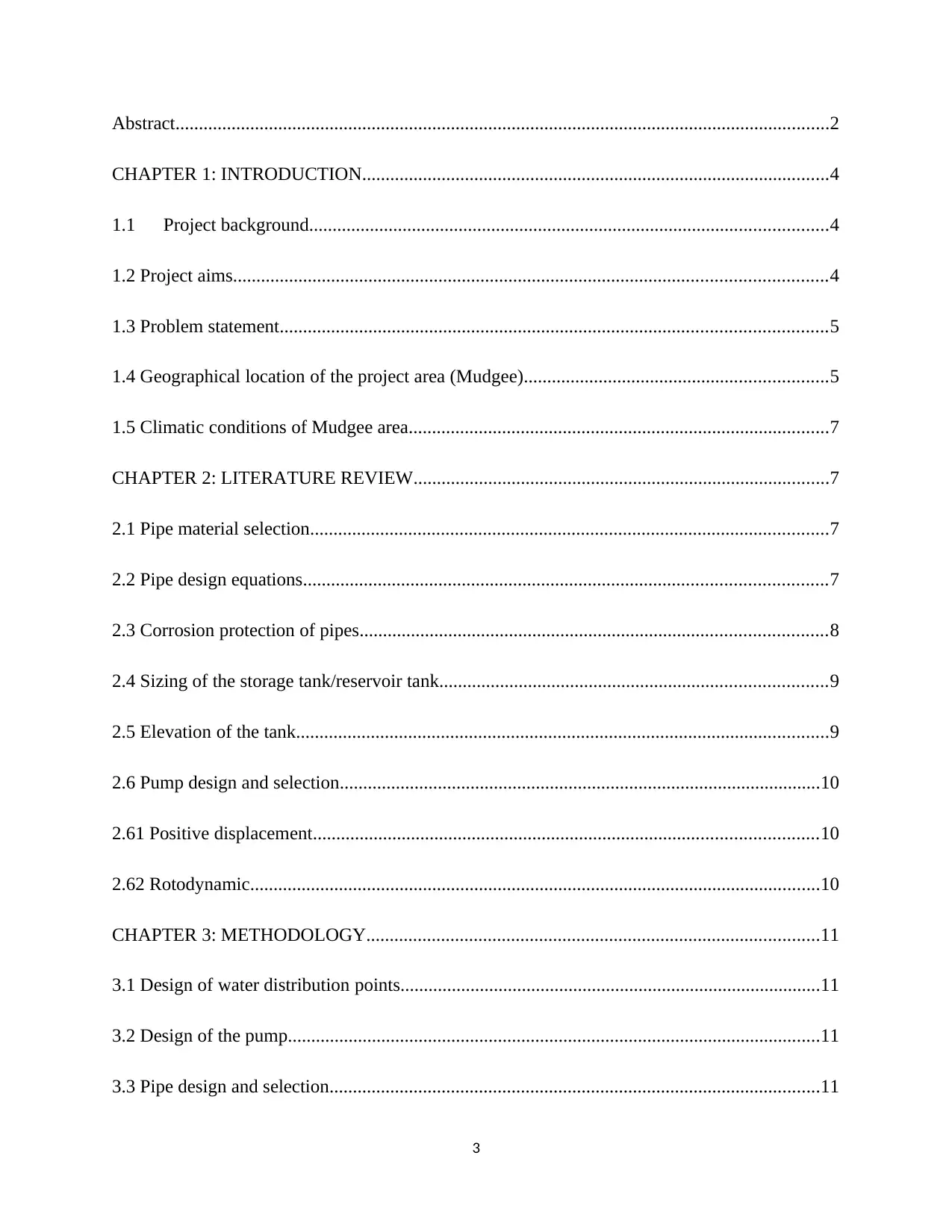
Abstract............................................................................................................................................2
CHAPTER 1: INTRODUCTION....................................................................................................4
1.1 Project background...............................................................................................................4
1.2 Project aims...............................................................................................................................4
1.3 Problem statement.....................................................................................................................5
1.4 Geographical location of the project area (Mudgee).................................................................5
1.5 Climatic conditions of Mudgee area..........................................................................................7
CHAPTER 2: LITERATURE REVIEW.........................................................................................7
2.1 Pipe material selection...............................................................................................................7
2.2 Pipe design equations................................................................................................................7
2.3 Corrosion protection of pipes....................................................................................................8
2.4 Sizing of the storage tank/reservoir tank...................................................................................9
2.5 Elevation of the tank..................................................................................................................9
2.6 Pump design and selection.......................................................................................................10
2.61 Positive displacement............................................................................................................10
2.62 Rotodynamic..........................................................................................................................10
CHAPTER 3: METHODOLOGY.................................................................................................11
3.1 Design of water distribution points..........................................................................................11
3.2 Design of the pump..................................................................................................................11
3.3 Pipe design and selection.........................................................................................................11
3
CHAPTER 1: INTRODUCTION....................................................................................................4
1.1 Project background...............................................................................................................4
1.2 Project aims...............................................................................................................................4
1.3 Problem statement.....................................................................................................................5
1.4 Geographical location of the project area (Mudgee).................................................................5
1.5 Climatic conditions of Mudgee area..........................................................................................7
CHAPTER 2: LITERATURE REVIEW.........................................................................................7
2.1 Pipe material selection...............................................................................................................7
2.2 Pipe design equations................................................................................................................7
2.3 Corrosion protection of pipes....................................................................................................8
2.4 Sizing of the storage tank/reservoir tank...................................................................................9
2.5 Elevation of the tank..................................................................................................................9
2.6 Pump design and selection.......................................................................................................10
2.61 Positive displacement............................................................................................................10
2.62 Rotodynamic..........................................................................................................................10
CHAPTER 3: METHODOLOGY.................................................................................................11
3.1 Design of water distribution points..........................................................................................11
3.2 Design of the pump..................................................................................................................11
3.3 Pipe design and selection.........................................................................................................11
3
⊘ This is a preview!⊘
Do you want full access?
Subscribe today to unlock all pages.

Trusted by 1+ million students worldwide
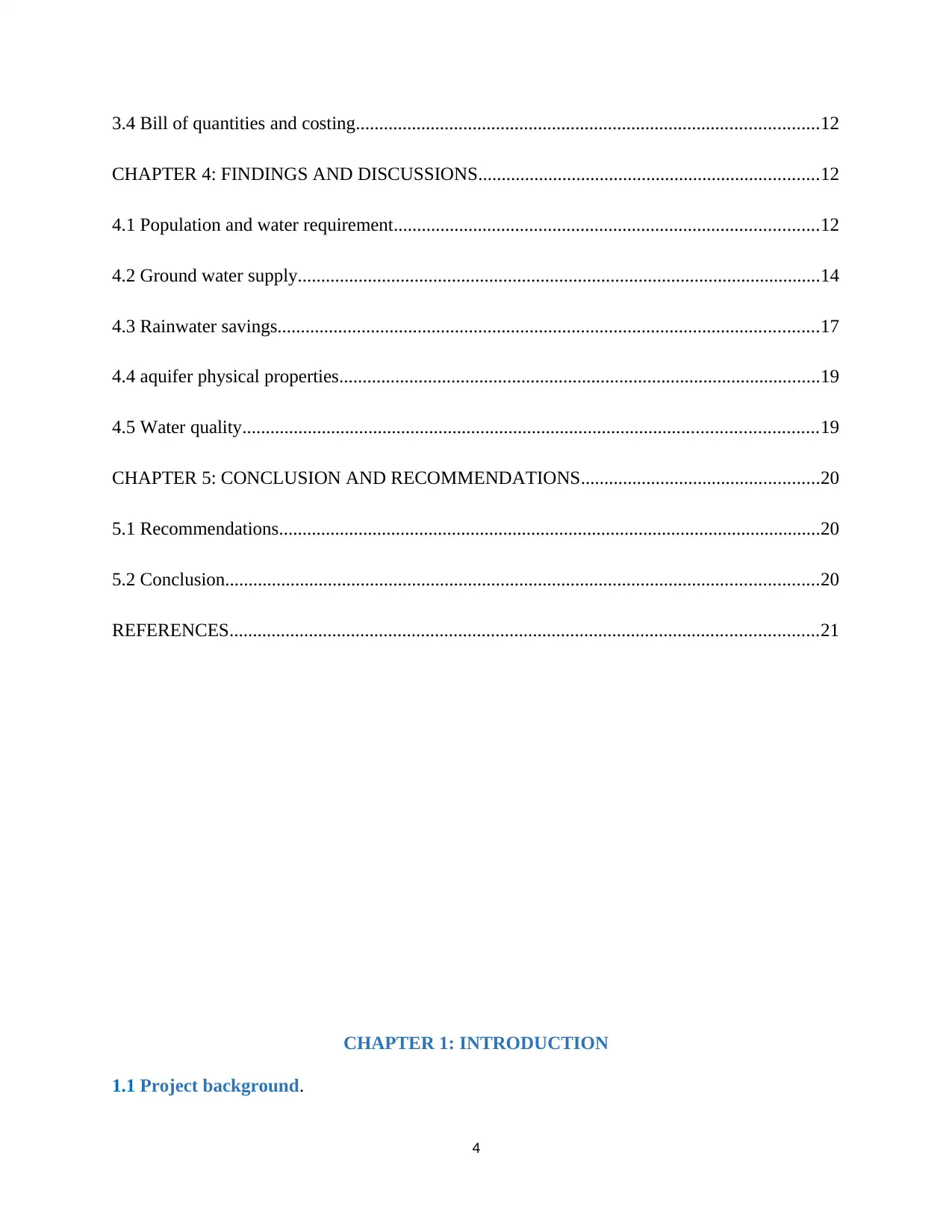
3.4 Bill of quantities and costing...................................................................................................12
CHAPTER 4: FINDINGS AND DISCUSSIONS.........................................................................12
4.1 Population and water requirement...........................................................................................12
4.2 Ground water supply................................................................................................................14
4.3 Rainwater savings....................................................................................................................17
4.4 aquifer physical properties.......................................................................................................19
4.5 Water quality...........................................................................................................................19
CHAPTER 5: CONCLUSION AND RECOMMENDATIONS...................................................20
5.1 Recommendations....................................................................................................................20
5.2 Conclusion...............................................................................................................................20
REFERENCES..............................................................................................................................21
CHAPTER 1: INTRODUCTION
1.1 Project background.
4
CHAPTER 4: FINDINGS AND DISCUSSIONS.........................................................................12
4.1 Population and water requirement...........................................................................................12
4.2 Ground water supply................................................................................................................14
4.3 Rainwater savings....................................................................................................................17
4.4 aquifer physical properties.......................................................................................................19
4.5 Water quality...........................................................................................................................19
CHAPTER 5: CONCLUSION AND RECOMMENDATIONS...................................................20
5.1 Recommendations....................................................................................................................20
5.2 Conclusion...............................................................................................................................20
REFERENCES..............................................................................................................................21
CHAPTER 1: INTRODUCTION
1.1 Project background.
4
Paraphrase This Document
Need a fresh take? Get an instant paraphrase of this document with our AI Paraphraser
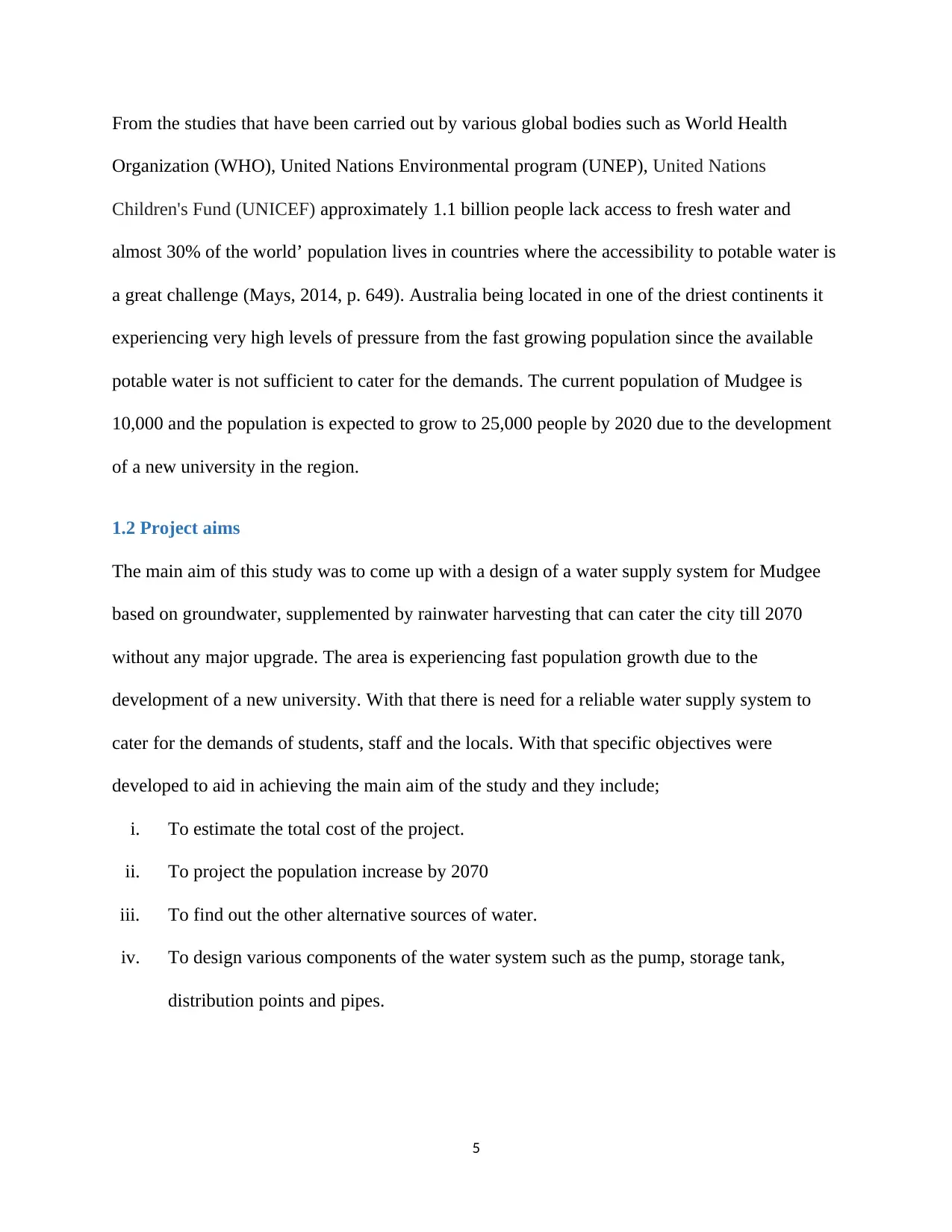
From the studies that have been carried out by various global bodies such as World Health
Organization (WHO), United Nations Environmental program (UNEP), United Nations
Children's Fund (UNICEF) approximately 1.1 billion people lack access to fresh water and
almost 30% of the world’ population lives in countries where the accessibility to potable water is
a great challenge (Mays, 2014, p. 649). Australia being located in one of the driest continents it
experiencing very high levels of pressure from the fast growing population since the available
potable water is not sufficient to cater for the demands. The current population of Mudgee is
10,000 and the population is expected to grow to 25,000 people by 2020 due to the development
of a new university in the region.
1.2 Project aims
The main aim of this study was to come up with a design of a water supply system for Mudgee
based on groundwater, supplemented by rainwater harvesting that can cater the city till 2070
without any major upgrade. The area is experiencing fast population growth due to the
development of a new university. With that there is need for a reliable water supply system to
cater for the demands of students, staff and the locals. With that specific objectives were
developed to aid in achieving the main aim of the study and they include;
i. To estimate the total cost of the project.
ii. To project the population increase by 2070
iii. To find out the other alternative sources of water.
iv. To design various components of the water system such as the pump, storage tank,
distribution points and pipes.
5
Organization (WHO), United Nations Environmental program (UNEP), United Nations
Children's Fund (UNICEF) approximately 1.1 billion people lack access to fresh water and
almost 30% of the world’ population lives in countries where the accessibility to potable water is
a great challenge (Mays, 2014, p. 649). Australia being located in one of the driest continents it
experiencing very high levels of pressure from the fast growing population since the available
potable water is not sufficient to cater for the demands. The current population of Mudgee is
10,000 and the population is expected to grow to 25,000 people by 2020 due to the development
of a new university in the region.
1.2 Project aims
The main aim of this study was to come up with a design of a water supply system for Mudgee
based on groundwater, supplemented by rainwater harvesting that can cater the city till 2070
without any major upgrade. The area is experiencing fast population growth due to the
development of a new university. With that there is need for a reliable water supply system to
cater for the demands of students, staff and the locals. With that specific objectives were
developed to aid in achieving the main aim of the study and they include;
i. To estimate the total cost of the project.
ii. To project the population increase by 2070
iii. To find out the other alternative sources of water.
iv. To design various components of the water system such as the pump, storage tank,
distribution points and pipes.
5
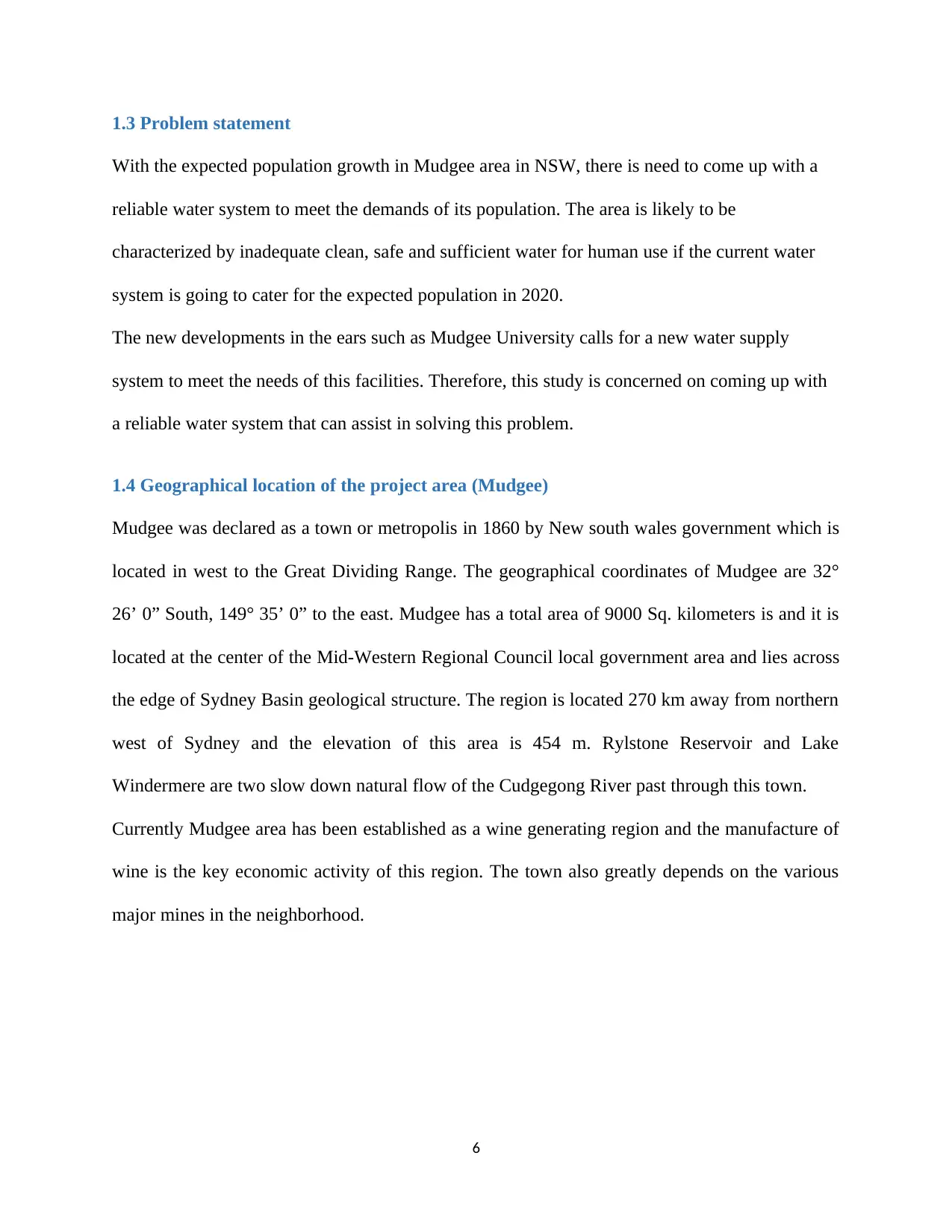
1.3 Problem statement
With the expected population growth in Mudgee area in NSW, there is need to come up with a
reliable water system to meet the demands of its population. The area is likely to be
characterized by inadequate clean, safe and sufficient water for human use if the current water
system is going to cater for the expected population in 2020.
The new developments in the ears such as Mudgee University calls for a new water supply
system to meet the needs of this facilities. Therefore, this study is concerned on coming up with
a reliable water system that can assist in solving this problem.
1.4 Geographical location of the project area (Mudgee)
Mudgee was declared as a town or metropolis in 1860 by New south wales government which is
located in west to the Great Dividing Range. The geographical coordinates of Mudgee are 32°
26’ 0” South, 149° 35’ 0” to the east. Mudgee has a total area of 9000 Sq. kilometers is and it is
located at the center of the Mid-Western Regional Council local government area and lies across
the edge of Sydney Basin geological structure. The region is located 270 km away from northern
west of Sydney and the elevation of this area is 454 m. Rylstone Reservoir and Lake
Windermere are two slow down natural flow of the Cudgegong River past through this town.
Currently Mudgee area has been established as a wine generating region and the manufacture of
wine is the key economic activity of this region. The town also greatly depends on the various
major mines in the neighborhood.
6
With the expected population growth in Mudgee area in NSW, there is need to come up with a
reliable water system to meet the demands of its population. The area is likely to be
characterized by inadequate clean, safe and sufficient water for human use if the current water
system is going to cater for the expected population in 2020.
The new developments in the ears such as Mudgee University calls for a new water supply
system to meet the needs of this facilities. Therefore, this study is concerned on coming up with
a reliable water system that can assist in solving this problem.
1.4 Geographical location of the project area (Mudgee)
Mudgee was declared as a town or metropolis in 1860 by New south wales government which is
located in west to the Great Dividing Range. The geographical coordinates of Mudgee are 32°
26’ 0” South, 149° 35’ 0” to the east. Mudgee has a total area of 9000 Sq. kilometers is and it is
located at the center of the Mid-Western Regional Council local government area and lies across
the edge of Sydney Basin geological structure. The region is located 270 km away from northern
west of Sydney and the elevation of this area is 454 m. Rylstone Reservoir and Lake
Windermere are two slow down natural flow of the Cudgegong River past through this town.
Currently Mudgee area has been established as a wine generating region and the manufacture of
wine is the key economic activity of this region. The town also greatly depends on the various
major mines in the neighborhood.
6
⊘ This is a preview!⊘
Do you want full access?
Subscribe today to unlock all pages.

Trusted by 1+ million students worldwide
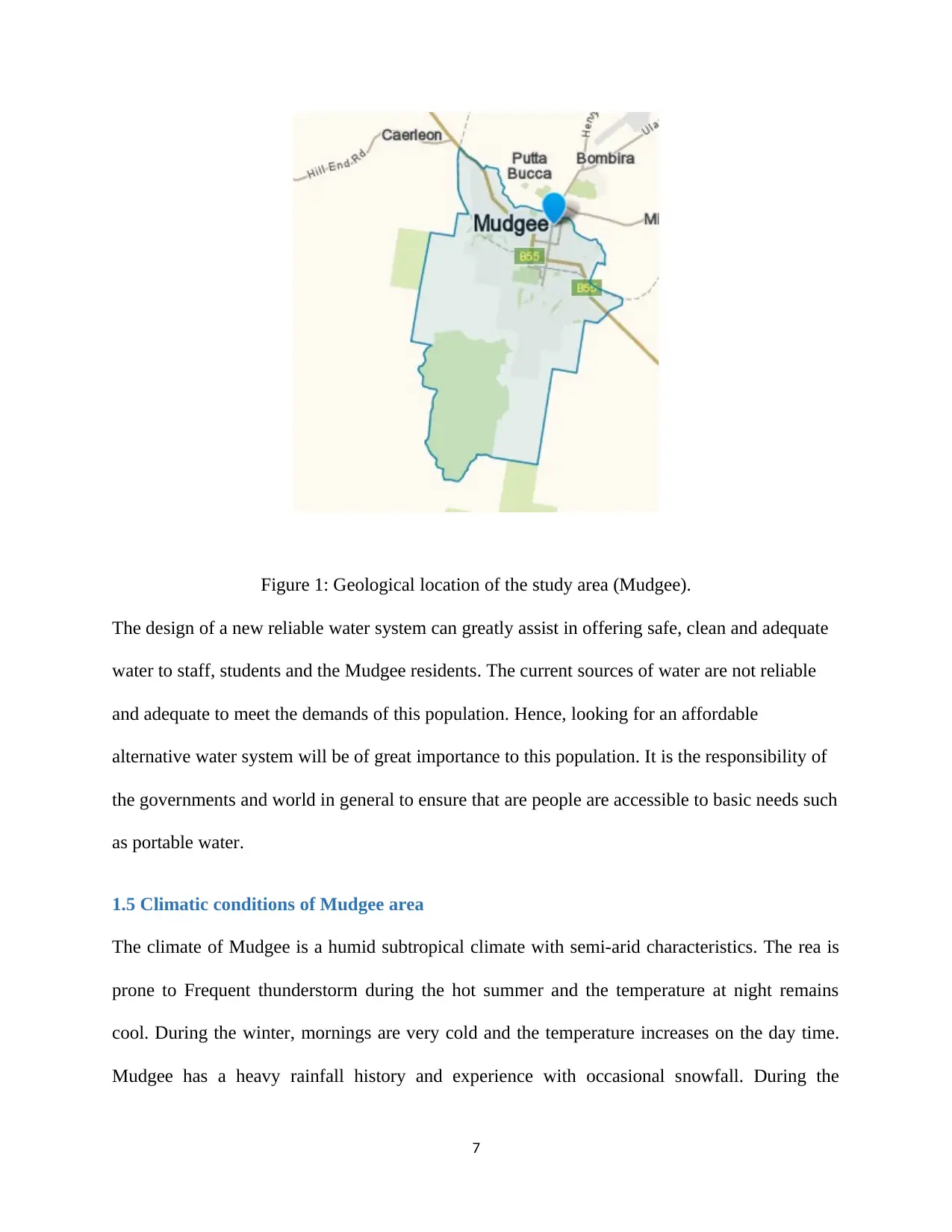
Figure 1: Geological location of the study area (Mudgee).
The design of a new reliable water system can greatly assist in offering safe, clean and adequate
water to staff, students and the Mudgee residents. The current sources of water are not reliable
and adequate to meet the demands of this population. Hence, looking for an affordable
alternative water system will be of great importance to this population. It is the responsibility of
the governments and world in general to ensure that are people are accessible to basic needs such
as portable water.
1.5 Climatic conditions of Mudgee area
The climate of Mudgee is a humid subtropical climate with semi-arid characteristics. The rea is
prone to Frequent thunderstorm during the hot summer and the temperature at night remains
cool. During the winter, mornings are very cold and the temperature increases on the day time.
Mudgee has a heavy rainfall history and experience with occasional snowfall. During the
7
The design of a new reliable water system can greatly assist in offering safe, clean and adequate
water to staff, students and the Mudgee residents. The current sources of water are not reliable
and adequate to meet the demands of this population. Hence, looking for an affordable
alternative water system will be of great importance to this population. It is the responsibility of
the governments and world in general to ensure that are people are accessible to basic needs such
as portable water.
1.5 Climatic conditions of Mudgee area
The climate of Mudgee is a humid subtropical climate with semi-arid characteristics. The rea is
prone to Frequent thunderstorm during the hot summer and the temperature at night remains
cool. During the winter, mornings are very cold and the temperature increases on the day time.
Mudgee has a heavy rainfall history and experience with occasional snowfall. During the
7
Paraphrase This Document
Need a fresh take? Get an instant paraphrase of this document with our AI Paraphraser
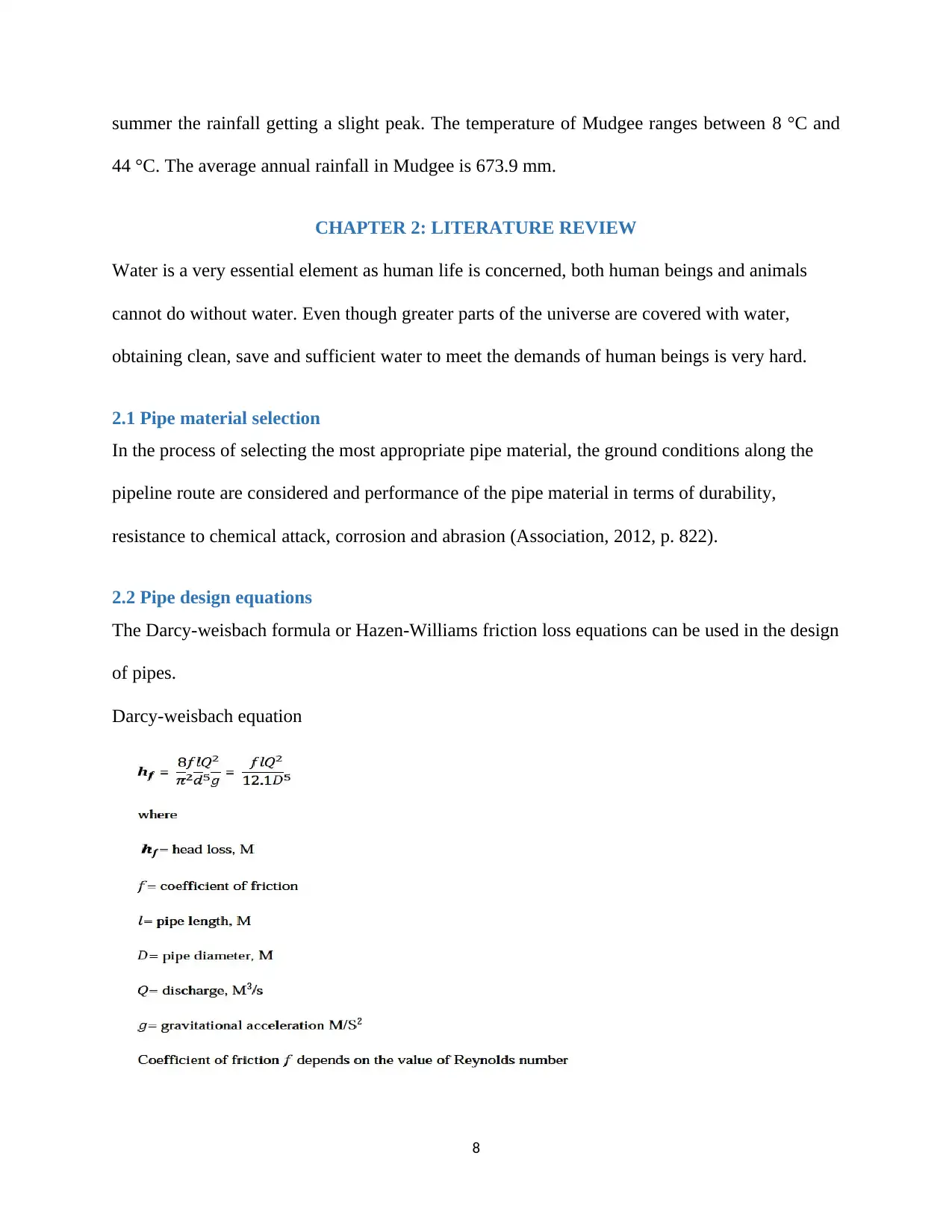
summer the rainfall getting a slight peak. The temperature of Mudgee ranges between 8 °C and
44 °C. The average annual rainfall in Mudgee is 673.9 mm.
CHAPTER 2: LITERATURE REVIEW
Water is a very essential element as human life is concerned, both human beings and animals
cannot do without water. Even though greater parts of the universe are covered with water,
obtaining clean, save and sufficient water to meet the demands of human beings is very hard.
2.1 Pipe material selection
In the process of selecting the most appropriate pipe material, the ground conditions along the
pipeline route are considered and performance of the pipe material in terms of durability,
resistance to chemical attack, corrosion and abrasion (Association, 2012, p. 822).
2.2 Pipe design equations
The Darcy-weisbach formula or Hazen-Williams friction loss equations can be used in the design
of pipes.
Darcy-weisbach equation
8
44 °C. The average annual rainfall in Mudgee is 673.9 mm.
CHAPTER 2: LITERATURE REVIEW
Water is a very essential element as human life is concerned, both human beings and animals
cannot do without water. Even though greater parts of the universe are covered with water,
obtaining clean, save and sufficient water to meet the demands of human beings is very hard.
2.1 Pipe material selection
In the process of selecting the most appropriate pipe material, the ground conditions along the
pipeline route are considered and performance of the pipe material in terms of durability,
resistance to chemical attack, corrosion and abrasion (Association, 2012, p. 822).
2.2 Pipe design equations
The Darcy-weisbach formula or Hazen-Williams friction loss equations can be used in the design
of pipes.
Darcy-weisbach equation
8
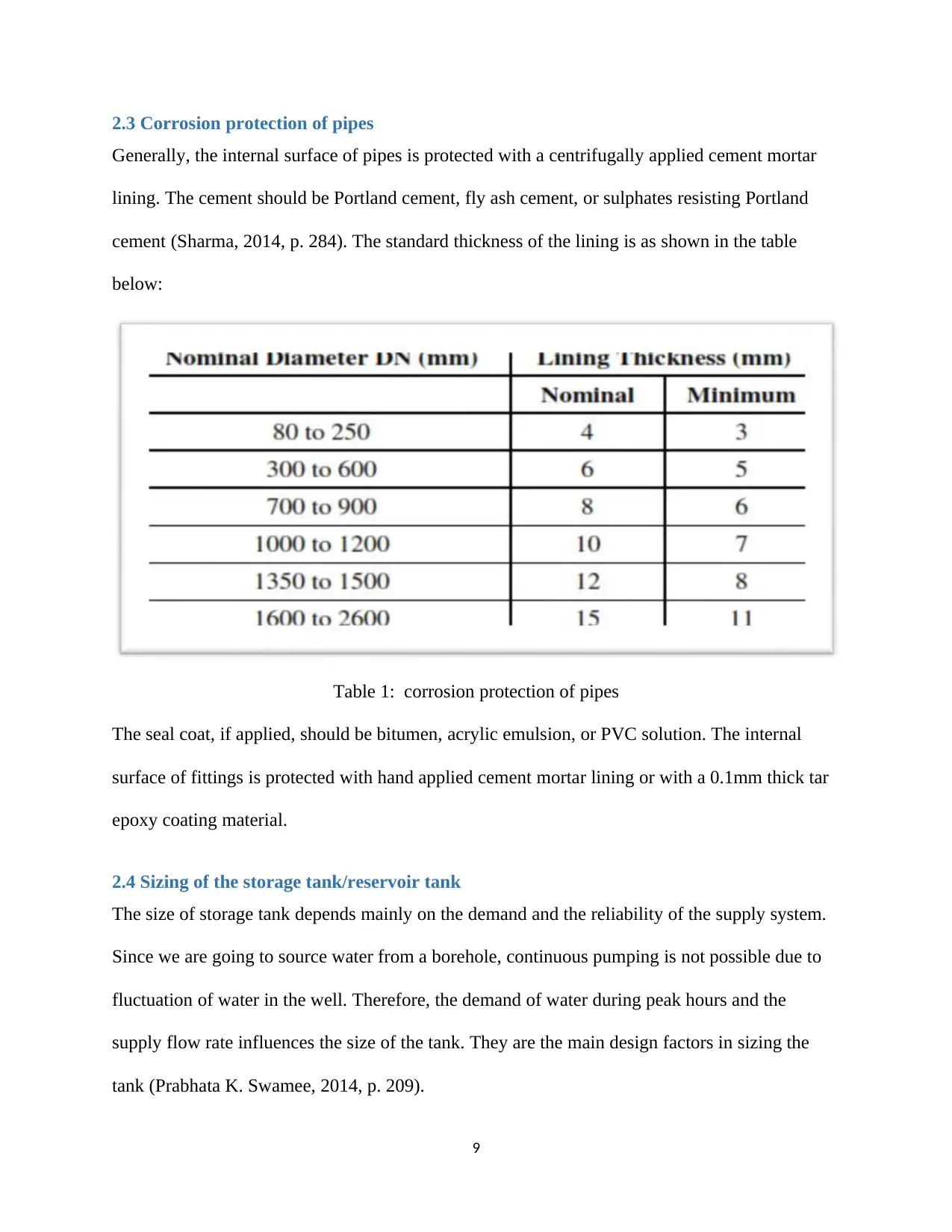
2.3 Corrosion protection of pipes
Generally, the internal surface of pipes is protected with a centrifugally applied cement mortar
lining. The cement should be Portland cement, fly ash cement, or sulphates resisting Portland
cement (Sharma, 2014, p. 284). The standard thickness of the lining is as shown in the table
below:
Table 1: corrosion protection of pipes
The seal coat, if applied, should be bitumen, acrylic emulsion, or PVC solution. The internal
surface of fittings is protected with hand applied cement mortar lining or with a 0.1mm thick tar
epoxy coating material.
2.4 Sizing of the storage tank/reservoir tank
The size of storage tank depends mainly on the demand and the reliability of the supply system.
Since we are going to source water from a borehole, continuous pumping is not possible due to
fluctuation of water in the well. Therefore, the demand of water during peak hours and the
supply flow rate influences the size of the tank. They are the main design factors in sizing the
tank (Prabhata K. Swamee, 2014, p. 209).
9
Generally, the internal surface of pipes is protected with a centrifugally applied cement mortar
lining. The cement should be Portland cement, fly ash cement, or sulphates resisting Portland
cement (Sharma, 2014, p. 284). The standard thickness of the lining is as shown in the table
below:
Table 1: corrosion protection of pipes
The seal coat, if applied, should be bitumen, acrylic emulsion, or PVC solution. The internal
surface of fittings is protected with hand applied cement mortar lining or with a 0.1mm thick tar
epoxy coating material.
2.4 Sizing of the storage tank/reservoir tank
The size of storage tank depends mainly on the demand and the reliability of the supply system.
Since we are going to source water from a borehole, continuous pumping is not possible due to
fluctuation of water in the well. Therefore, the demand of water during peak hours and the
supply flow rate influences the size of the tank. They are the main design factors in sizing the
tank (Prabhata K. Swamee, 2014, p. 209).
9
⊘ This is a preview!⊘
Do you want full access?
Subscribe today to unlock all pages.

Trusted by 1+ million students worldwide
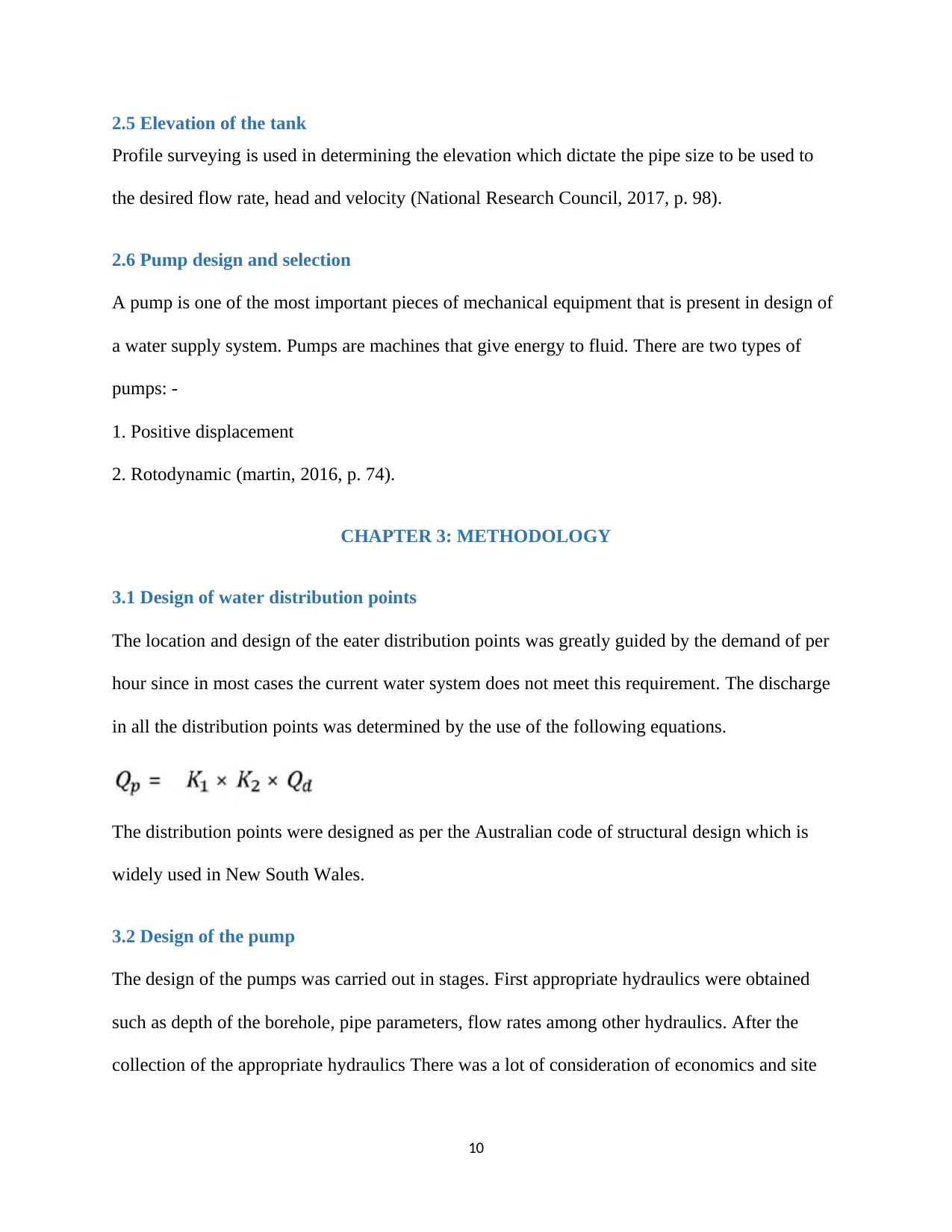
2.5 Elevation of the tank
Profile surveying is used in determining the elevation which dictate the pipe size to be used to
the desired flow rate, head and velocity (National Research Council, 2017, p. 98).
2.6 Pump design and selection
A pump is one of the most important pieces of mechanical equipment that is present in design of
a water supply system. Pumps are machines that give energy to fluid. There are two types of
pumps: -
1. Positive displacement
2. Rotodynamic (martin, 2016, p. 74).
CHAPTER 3: METHODOLOGY
3.1 Design of water distribution points
The location and design of the eater distribution points was greatly guided by the demand of per
hour since in most cases the current water system does not meet this requirement. The discharge
in all the distribution points was determined by the use of the following equations.
The distribution points were designed as per the Australian code of structural design which is
widely used in New South Wales.
3.2 Design of the pump
The design of the pumps was carried out in stages. First appropriate hydraulics were obtained
such as depth of the borehole, pipe parameters, flow rates among other hydraulics. After the
collection of the appropriate hydraulics There was a lot of consideration of economics and site
10
Profile surveying is used in determining the elevation which dictate the pipe size to be used to
the desired flow rate, head and velocity (National Research Council, 2017, p. 98).
2.6 Pump design and selection
A pump is one of the most important pieces of mechanical equipment that is present in design of
a water supply system. Pumps are machines that give energy to fluid. There are two types of
pumps: -
1. Positive displacement
2. Rotodynamic (martin, 2016, p. 74).
CHAPTER 3: METHODOLOGY
3.1 Design of water distribution points
The location and design of the eater distribution points was greatly guided by the demand of per
hour since in most cases the current water system does not meet this requirement. The discharge
in all the distribution points was determined by the use of the following equations.
The distribution points were designed as per the Australian code of structural design which is
widely used in New South Wales.
3.2 Design of the pump
The design of the pumps was carried out in stages. First appropriate hydraulics were obtained
such as depth of the borehole, pipe parameters, flow rates among other hydraulics. After the
collection of the appropriate hydraulics There was a lot of consideration of economics and site
10
Paraphrase This Document
Need a fresh take? Get an instant paraphrase of this document with our AI Paraphraser
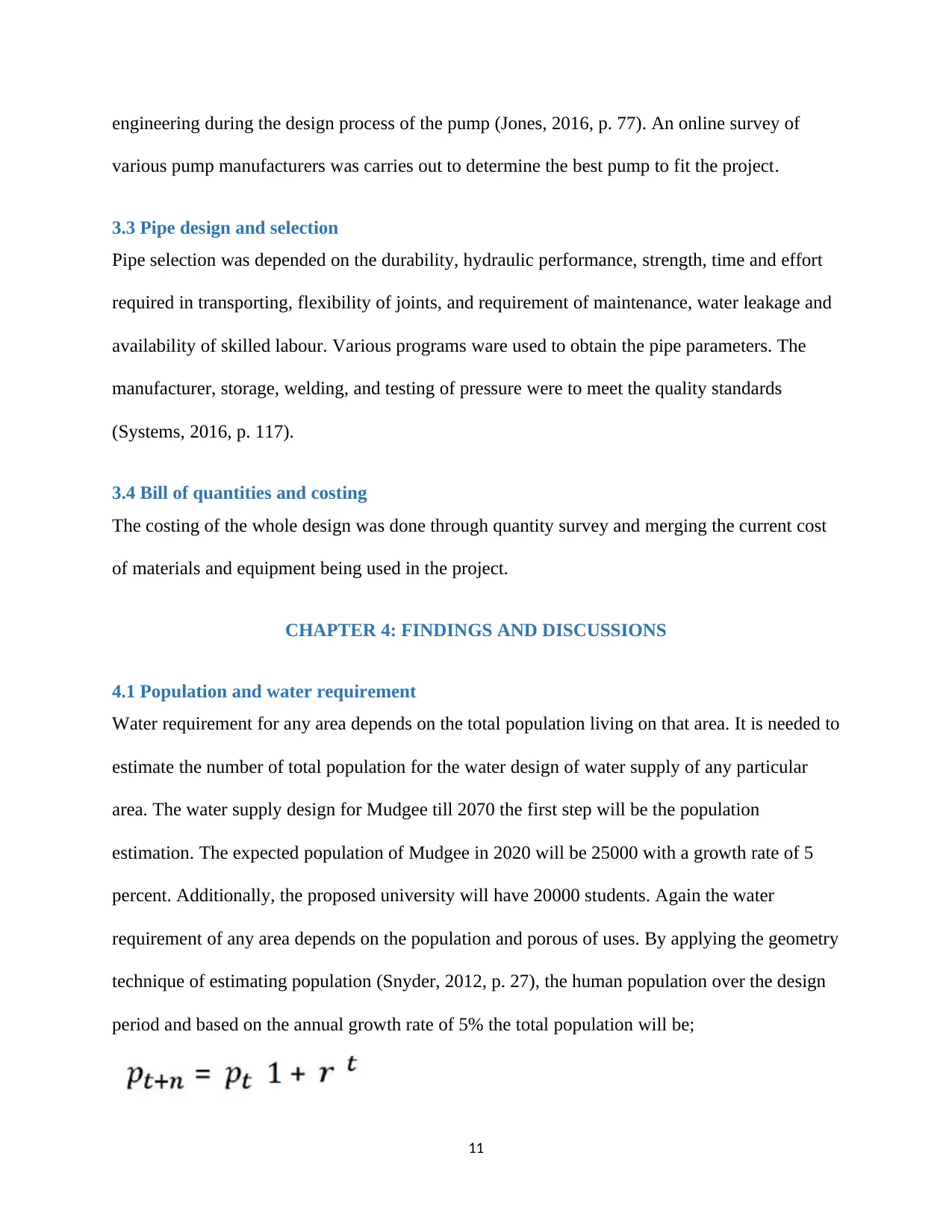
engineering during the design process of the pump (Jones, 2016, p. 77). An online survey of
various pump manufacturers was carries out to determine the best pump to fit the project.
3.3 Pipe design and selection
Pipe selection was depended on the durability, hydraulic performance, strength, time and effort
required in transporting, flexibility of joints, and requirement of maintenance, water leakage and
availability of skilled labour. Various programs ware used to obtain the pipe parameters. The
manufacturer, storage, welding, and testing of pressure were to meet the quality standards
(Systems, 2016, p. 117).
3.4 Bill of quantities and costing
The costing of the whole design was done through quantity survey and merging the current cost
of materials and equipment being used in the project.
CHAPTER 4: FINDINGS AND DISCUSSIONS
4.1 Population and water requirement
Water requirement for any area depends on the total population living on that area. It is needed to
estimate the number of total population for the water design of water supply of any particular
area. The water supply design for Mudgee till 2070 the first step will be the population
estimation. The expected population of Mudgee in 2020 will be 25000 with a growth rate of 5
percent. Additionally, the proposed university will have 20000 students. Again the water
requirement of any area depends on the population and porous of uses. By applying the geometry
technique of estimating population (Snyder, 2012, p. 27), the human population over the design
period and based on the annual growth rate of 5% the total population will be;
11
various pump manufacturers was carries out to determine the best pump to fit the project.
3.3 Pipe design and selection
Pipe selection was depended on the durability, hydraulic performance, strength, time and effort
required in transporting, flexibility of joints, and requirement of maintenance, water leakage and
availability of skilled labour. Various programs ware used to obtain the pipe parameters. The
manufacturer, storage, welding, and testing of pressure were to meet the quality standards
(Systems, 2016, p. 117).
3.4 Bill of quantities and costing
The costing of the whole design was done through quantity survey and merging the current cost
of materials and equipment being used in the project.
CHAPTER 4: FINDINGS AND DISCUSSIONS
4.1 Population and water requirement
Water requirement for any area depends on the total population living on that area. It is needed to
estimate the number of total population for the water design of water supply of any particular
area. The water supply design for Mudgee till 2070 the first step will be the population
estimation. The expected population of Mudgee in 2020 will be 25000 with a growth rate of 5
percent. Additionally, the proposed university will have 20000 students. Again the water
requirement of any area depends on the population and porous of uses. By applying the geometry
technique of estimating population (Snyder, 2012, p. 27), the human population over the design
period and based on the annual growth rate of 5% the total population will be;
11
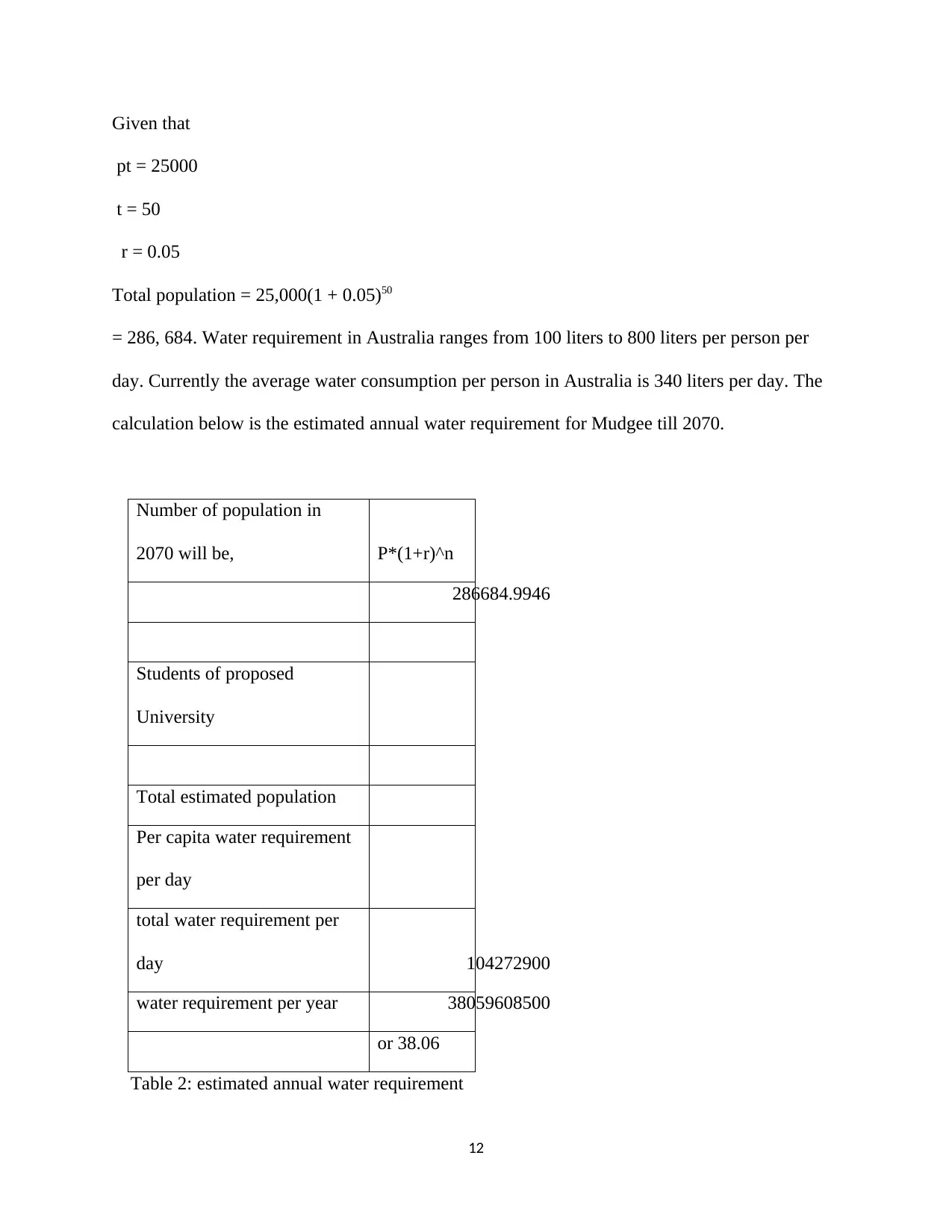
Given that
.pt = 25000
.t = 50
. r = 0.05
Total population = 25,000(1 + 0.05)50
= 286, 684. Water requirement in Australia ranges from 100 liters to 800 liters per person per
day. Currently the average water consumption per person in Australia is 340 liters per day. The
calculation below is the estimated annual water requirement for Mudgee till 2070.
Number of population in
2070 will be, P*(1+r)^n
286684.9946
Students of proposed
University
Total estimated population
Per capita water requirement
per day
total water requirement per
day 104272900
water requirement per year 38059608500
or 38.06
Table 2: estimated annual water requirement
12
.pt = 25000
.t = 50
. r = 0.05
Total population = 25,000(1 + 0.05)50
= 286, 684. Water requirement in Australia ranges from 100 liters to 800 liters per person per
day. Currently the average water consumption per person in Australia is 340 liters per day. The
calculation below is the estimated annual water requirement for Mudgee till 2070.
Number of population in
2070 will be, P*(1+r)^n
286684.9946
Students of proposed
University
Total estimated population
Per capita water requirement
per day
total water requirement per
day 104272900
water requirement per year 38059608500
or 38.06
Table 2: estimated annual water requirement
12
⊘ This is a preview!⊘
Do you want full access?
Subscribe today to unlock all pages.

Trusted by 1+ million students worldwide
1 out of 21
Related Documents
Your All-in-One AI-Powered Toolkit for Academic Success.
+13062052269
info@desklib.com
Available 24*7 on WhatsApp / Email
![[object Object]](/_next/static/media/star-bottom.7253800d.svg)
Unlock your academic potential
Copyright © 2020–2025 A2Z Services. All Rights Reserved. Developed and managed by ZUCOL.




